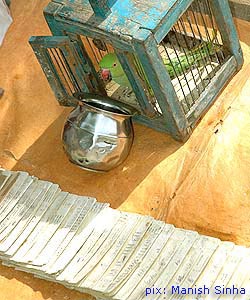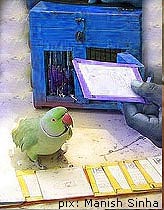|  Alex
,an African Grey parrot , died in September at the age of 31. His last words to
his longtime trainer, animal psychologist Irene Pepperberg, were, "You be
good. I love you." The words themselves bring a lump to my throat. The bird
knew he was dying and his last words were what my father would have said to me. Alex
,an African Grey parrot , died in September at the age of 31. His last words to
his longtime trainer, animal psychologist Irene Pepperberg, were, "You be
good. I love you." The words themselves bring a lump to my throat. The bird
knew he was dying and his last words were what my father would have said to me.
Pepperberg's
work with Alex has cast a new light on the intelligence of birds. She bought him
30 years ago at a pet shop to find out how much African grey parrots can be taught.
The answer - more than anyone had imagined. Alex learnt hundreds of words and
used them correctly to communicate . He distinguished shapes and colors, as well
as the concepts of "same" and different," and "bigger"
and "smaller." He could count and was able to express his desires, including
his frustration with repetitive research which he showed by stopping work, beginning
to preen, or interrupts with many successive requests for other items or changes
of location
After rubbing his beak on an object, he could correctly name what it was made
of – "wool," for example. When he tired of an experiment, he'd
say, "Wanna go back" (to his cage). When he sensed that Pepperberg was
losing patience with him, he'd say, "I'm sorry."When Alex asked for
a treat – say, a grape – that's exactly what he wanted; he'd reject
anything else offered him until he got the grape. The
scientists say that every parrot – and every bird perhaps, is as smart. In
the last few decades, scientists have begun to understand that animals are intelligent
in ways that people were too blind to see in the past. This belief that animals
cannot think, they act on programmed instinct is now as obsolete as the belief
that the earth is flat. New
York Times columnist Verlyn Klinkenborg summed up the irony of Alex : "We're
too invested in the idea of our superiority to understand what an inferior quality
it really is. I always wonder how the experiments would go if they were reversed—if,
instead of us trying to teach Alex how to use the English language, Alex were
to try teaching us to understand the world as it appears to parrots."
Dolphins,
elephants, primates – it is now taken for granted that most mammals have
intelligence and emotion akin to that of humans. Even though any bird enthusiast
can tell you that birds do too – just by seeing their community interactions,
their ability to fly across continents to get to the same tree across the world,
their intricate nests, their wars and songs , their love for each other and their
care of children , it takes an Alex to make us understand that birds are every
bit as intelligent as us and no person in their right minds should keep them in
cages.  Parrots
are social birds whose cognitive and language skills are very high. Unfortunately
, instead of trying to understand their own language and communication in the
wild , t he ability of some species of parrots to mimic human voices has led to
the assault on all species of parrots. Most cannot speak or at best will repeat
a few words that are endlessly and moronically pushed on them . In return for
this , they become display items condemned to jail forever. Parrots
are social birds whose cognitive and language skills are very high. Unfortunately
, instead of trying to understand their own language and communication in the
wild , t he ability of some species of parrots to mimic human voices has led to
the assault on all species of parrots. Most cannot speak or at best will repeat
a few words that are endlessly and moronically pushed on them . In return for
this , they become display items condemned to jail forever.
Till now
parrots were not mentioned in discussions about nonhuman intelligence, much data
exist to establish their brain power. Field studies have reported behaviors that
are considered as evidence for human-like intelligence. Such behaviors include
cooperative alarm signaling in flocks of Indigo macaws and individual recognition
in Bahamian Amazons .Another sign of intelligence, thought to be absent in most
nonhuman animals, is the ability to engage in complex, meaningful communication.
Alex
showed that when he was taught a new word or task, that he was capable of using
this information in a new way by applying it to a situation where he was not taught
the correct response or action. Since
the 1970's researchers working both in the field and in aviary settings have provided
data to indicate that natural parrot vocalizations are meaningful: Social interactions
between mated pairs and among flock members are accompanied by a great deal of
talking, and not only the physical structure but also the appropriate use of these
vocalizations seems to be learned.Such findings on sophisticated vocal behaviors,
when taken in conjunction with the data on complex problem-solving abilities (one
study gives parrots the same success rate as humans in a comparable study) show
that parrots have a level of competence of a chimpanzee,dolphin,elephant or a
young human. Scientists
grudgingly admit that parrot Intelligence surpasses that of dogs and cats - sometimes
even their owners! With this large brain power comes strong emotions.They are
boisterous, playful, loving and also prone to fits and tantrums. Parrots I the
wild are as noisy as humans.They chatter, mock, squeak, beep, grumble, groan,
growl and scream. How
many people realize that an intelligent creature needs constant stimulation. How
many simply put the bird in a cage and leave it there. In the only study (Goverment
Degree Collage, Saidabad, Allahabad )done on parrots in India to establish their
emotional intelligence the researchers reported that " Parrots make meaningful
use of vocalization and are able to associate words with their meanings and form
simple sentences. Parrots can remember names of family members and can distinguish
instruments and their use . We have found out that parrots are very good learners.
They also have emotions like human beings such as jealousy, love fear anger or
friendship" How intelligent are parrots in the wild ? . Keas, New Zealand
parrots, in a neat variation of ringing the doorbell and running away, are known
to drop rocks on roofs to make people run outside.
 Parrots
are divided into groups such as cockatoos, lories, lovebirds, macaws, and parakeets.How
long are these 360 species of parrots going to be around. The countdown started
years ago and now we are almost at the end. 95% of the millions of parrots sold
are caught illegally in the wild. Two million are traded in the United States
every year. On the internet , there are over 50,000 sites advertising parrots
for sale. In 2000 there were 60 million birds in 6.13 million homes in just the
US alone. In India there would be not less than 10 million parrots smuggled out
to feed this frenzy for caged birds and to supply our neighbouring countries.
In China practically every homes has a caged bird Parrots
are divided into groups such as cockatoos, lories, lovebirds, macaws, and parakeets.How
long are these 360 species of parrots going to be around. The countdown started
years ago and now we are almost at the end. 95% of the millions of parrots sold
are caught illegally in the wild. Two million are traded in the United States
every year. On the internet , there are over 50,000 sites advertising parrots
for sale. In 2000 there were 60 million birds in 6.13 million homes in just the
US alone. In India there would be not less than 10 million parrots smuggled out
to feed this frenzy for caged birds and to supply our neighbouring countries.
In China practically every homes has a caged bird
Of
the 140 parrot species of the West , 30% are almost extinct. 35% are almost extinct
in South America and Asia.40 % of the species are threatened by the cutting of
forests, 17 % by trade, 36 % by a combination of the two causes. More than 30%
of these traded animals are taken from their nests and packed into small boxes
and smuggled in trucks under other material across borders. They die of suffocation,starvation,inhumane
treatment.Ten species of parrot have gone extinct simply because museums needed
specimens .171 species are currently on the list of endangered species. Their
colours ,mannerisms and ability to talk make them the target of trappers for the
pet trade. When was the last time you saw a budgerigar or love bird in the wild
? Never. They used to live in large groups of upto one lakh in a single flock
in Australia. Now you just see them in pet shops.From the tiny Buff-faced Pygmy
Parrot from Papua New Guinea to the largest Hyacinth Macaw in South America all
of them are being killed by bird fanciers. . People
who would never think of locking up a cat or dog in a cage don't worry about buying
parrots – who are every bit as intelligent and aware as these animals –
and keeping them in cages for their entire lives. Are you one of them ? To
join the animal welfare movement contact : gandhim@nic.in previous
articles...
1. Human Propensities of Cow 2.Trade
in WildLife Comment |